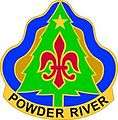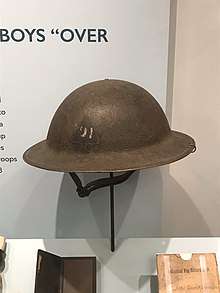91st Division (United States)
The 91st Infantry Division (famously nicknamed as the "Wild West Division"[2] with a "Fir Tree" as its Division insignia to symbolize its traditional home of the Far West[4]) is an infantry division of the United States Army that fought in World War I and World War II. From 1946 until 2008, it was part of the United States Army Reserve. It was briefly inactivated from 2008 until 2010 when it was elevated back to a division size element as the 91st Training Division (Operations).[1]
| 91st Infantry Division 91st Training Division (Operations) | |
|---|---|
 91st Infantry Division insignia | |
| Active | 1917–1919 1921-1945 1946–2009 2009-2010 2010–present |
| Country | |
| Branch | |
| Type | Infantry Training |
| Size | Division |
| Garrison/HQ | Fort Hunter Liggett[1] |
| Nickname(s) | "Wild West Division"(special designation)[2] "Powder River"[3] |
| Motto(s) | "Powder River, Let'er Buck!" |
| Engagements | World War I
|
| Website | 91st Training Division |
| Insignia | |
| Distinctive unit insignia |  |
History
World War I
_Infantry_Division_1940_Structure.png)

The Division was composed of the following units:[5] Constituted on 5 August 1917 at Camp Lewis, Washington, near Tacoma, the division soon thereafter departed for England in the summer of 1918. In September 1918, the division's first operation was in the St. Mihiel Offensive in France. Serving under the U.S. Army's V Corps, the division fought in the Meuse-Argonne Offensive and successfully helped to destroy the German First Guard Division and continued to smash through three successive enemy lines.[1][6]
Twelve days before the end of World War I, the division, as part of the VII Corps of the French Sixth Army, helped drive the Germans east across the Escaut River in the Battle of the Lys and the Escaut. The division was awarded separate campaign streamers for its active role in the Lorraine, Meuse-Argonne and Ypres-Lys campaigns.[1][6]
In 1919, the 91st was inactivated at the Presidio of San Francisco.
The Division was composed of the following units:[7][8][9][10][11]
- Headquarters, 91st Division
- 181st Infantry Brigade
- 361st Infantry Regiment
- 362nd Infantry Regiment
- 347th Machine Gun Battalion [12]
- 182nd Infantry Brigade
- 363rd Infantry Regiment
- 364th Infantry Regiment
- 348th Machine Gun Battalion
- 166th Field Artillery Brigade
- 346th Field Artillery Regiment (75 mm)
- 347th Field Artillery Regiment (4.7")
- 348th Field Artillery Regiment (155 mm)
- 316th Trench Mortar Battery
- 348th Machine Gun Battalion
- 316th Engineer Regiment
- 316th Medical Regiment
- 316th Field Signal Battalion
- Headquarters Troop, 91st Division
- 316th Train Headquarters and Military Police
- 316th Ammunition Train
- 316th Supply Train
- 316th Engineer Train
- 316th Sanitary Train
- 361st, 36nd, 363rd, and 364th Ambulance Companies and Field Hospitals
Interwar period
After being reconstituted in 1921 as part of the Organized Reserves and being assigned to the state of California, the division then served as an administrative control center for the next 21 years.[1][6]
World War II
As the early battles of World War II involving the United States were being fought, the division was reactivated at Camp White, Oregon on 15 August 1942, under the command of Major General Charles H. Gerhardt. After initial training at Camp White, the division participation in the Oregon Maneuver combat exercise in the fall of 1943.[13][14]

Order of battle
- Headquarters, 91st Infantry Division
- 361st Infantry Regiment
- 362nd Infantry Regiment
- 363rd Infantry Regiment
- Headquarters and Headquarters Battery, 91st Infantry Division Artillery
- 346th Field Artillery Battalion
- 347th Field Artillery Battalion
- 348th Field Artillery Battalion
- 916th Field Artillery Battalion
- 316th Engineer Combat Battalion
- 316th Medical Battalion
- 91st Cavalry Reconnaissance Troop (Mechanized)
- Headquarters, Special Troops, 91st Infantry Division
- Headquarters Company, 91st Infantry Division
- 791st Ordnance Light Maintenance Company
- 91st Quartermaster Company
- 91st Signal Company
- Military Police Platoon
- Band
- 91st Counterintelligence Corps Detachment
Then, the division, now under Major General William G. Livesay, departed for the European Continent on 3 April 1944. There, on the Italian Front, the 361st Regimental Combat Team was detached to participate in the battles for Rome and the Arno River. It became the first formation of the U.S. Fifth Army to reach the river. In September 1944, the division crossed the Sieve River, outflanked the famous Gothic Line, and captured the Futa Pass. For its part in combat, the division was awarded the North Apennines, Po Valley and Rome-Arno campaign streamers.
The division returned to the United States where it was inactivated at Camp Rucker, Alabama, in December 1945.[1][6] Two members were awarded the Medal of Honor during the war, Roy W. Harmon and Oscar G. Johnson.[15]
World War II statistics
Command structure
- Commanding generals: Major general Charles H. Gerhardt (May 1942 – 22 July 1943); Major general William G. Livesay (July 1943 – 5 November 1945); BG Neal C. Johnson (6 November 1945 - December 1945)
- Assistant Commanding generals: BG Percy W. Clarkson (- September 1942); BG Charles L. Bolte (September 1942 – February 1943); BG William E. Crist (April 1943 – December 1943); BG Raymond E. S. Williamson (14 January 1944 – 18 October 1945)
- Commanding Officers Artillery: BG Edward S. Ott (1942-1943); BG Ralph Hospital (1943-1945)
Other statistics
Awards: MH-2 ; DSC-2 ; DSM-1 ; SS-528; LM-33; SM-43 ; BSM-4,152.
Theater: Mediterranean
Days of combat: 271
Campaigns:
- Rome-Arno (22 Jan 44 – 9 Sep 44)
- North Apennines (10 Sep 44 – 4 April 45)
- Po Valley (5 Apr 45 – 8 May 45)
Casualties[16]
- Total battle casualties: 8,744
- Killed in action: 1,400
- Wounded in action: 6,748
- Missing in action: 262
- Prisoner of war: 334
Army Reserve

In December 1946, the 91st was reactivated at the Presidio of San Francisco as part of the U.S. Army Reserve. In 1959, the division was reorganized and redesignated as the 91st Division (Training). In 1993, the division was again reorganized and redesignated as the 91st Division (Exercise) and again in 1999 as the 91st Division (Training Support).[1][6]
Its headquarters was at Parks Reserve Forces Training Area (PRFTA), Dublin, California,[17] when the 2005 Base Realignment and Closure Commission recommended the Department of Defense relocate the 91st Division to Fort Hunter Liggett.[6]
The four brigades of the 91st Division were redesignated as separate brigades:
- 1st Brigade (PRFTA) is now 5th Brigade, 75th Division.
- 2nd Brigade (Fort Carson) is now 5th Armored Brigade.
- 3rd Brigade (Travis AFB) is now the 402nd Field Artillery Brigade.
- 4th Brigade (Fort Lewis) is now 191st Infantry Brigade.
The 91st Division moved its headquarters to Fort Hunter Liggett on 1 May 2009, was reorganized and re-designated as the 91st Training Brigade (Operations) on 1 October 2009 and was then re-designated as the 91st Training Division (Operations) on 1 October 2010.[1]
Subordinate units
As of 2017 the following units are subordinated to the 91st Training Division (Operations):
- 1st Brigade[18]
- 11th Battalion, 104th Regiment
- 3rd Battalion, 290th Regiment
- 2nd Battalion, 378th Regiment
- 3rd Battalion, 381st Regiment
- 1st Battalion, 417th Regiment
Notable members
- William Borders, Army Catholic Chaplain, was awarded the Bronze Star for Valor, while serving with the 362 Infantry Regiment in bitter fighting in Italy. He later became the Archbishop of Baltimore.
- Frederick Lippitt, politician and philanthropist.
- Oscar Franklin Miller, Medal of Honor recipient.
- Deming Bronson, Medal of Honor recipient.
- Earl Warren, Chief Justice of the United States[19]
In the Media
The soldiers in the TV show Combat! portray members of the 363rd Infantry Regiment.[20]
Shoulder Sleeve Insignia
 SSI for the 91st Infantry Division in World War 1
SSI for the 91st Infantry Division in World War 1 Variation SSI for the 91st Infantry Division in World War 1
Variation SSI for the 91st Infantry Division in World War 1 SSI for the 91st Infantry Division in World War 2
SSI for the 91st Infantry Division in World War 2
References
- "91st Training Division (Operations) History". United States Army. Archived from the original on 22 July 2011. Retrieved 17 February 2011.
- "Special Unit Designations". United States Army Center of Military History. 21 April 2010. Archived from the original on 9 July 2010. Retrieved 9 July 2010.
- "Lone Sentry: Unit History: 91st Infantry Division (Introduction)". www.lonesentry.com. Retrieved 20 April 2018.
- "Fort Baker". National Park Service. United States Department of the Interior. 20 July 2012. Retrieved 30 July 2012.
- http://www.history.army.mil/html/books/023/23-2/CMH_Pub_23-2.pdf Order of Battle in the Great War P373
- "91st Division (Training Support)". GlobalSecurity.org. 21 August 2008. Retrieved 17 February 2011.
- http://www.cgsc.edu/CARL/nafziger/918UKAA.pdf Archived 27 March 2016 at the Wayback Machine Nafziger collection
- The US Army Order of Battle from 1919-1941 p267
- The US Army Order of Battle from 1919-1941 p866
- The US Army Order of Battle from 1919-1941 p1734
- The US Army Order of Battle from 1919-1941 p1959, p2243
- History of the 347th Machine Gun Battalion. Oakland, California: Horwinski Company. 1923. Retrieved 11 October 2015.
- Kramer, George, “Camp White”, The Oregon Encyclopedia, Portland State University, Portland, Oregon, 23 October 2010.
- Brogan, Phil F., East of the Cascades (Third Edition), Binford & Mort, Portland, Oregon, 1965, pp. 272–275.
- Military History Network. Congressional Medal of Honor Recipients, Mediterranean Theater of Operations, World War II.
- Army Battle Casualties and Nonbattle Deaths, Final Report (Statistical and Accounting Branch, Office of the Adjutant General, 1 June 1953)
- "Camp Parks Reserve Forces Training Area (PRFTA)". Camp Parks Reserve Forces Training Area (PRFTA). GlobalSecurity.org. 21 August 2008. Retrieved 17 February 2011.
- "U.S. Army Reserve > Commands > Functional > 84th TNG CMD". www.usar.army.mil. Retrieved 20 April 2018.
- White, G. Edward (15 July 1982). Earl Warren, a public life. Oxford University Press. ISBN 0-19-503121-0.
- https://www.youtube.com/watch?v=jh7tCjRzD90&list=PLfQk6ph47fOzjRNdlvAtWO_GtkZmUiJuZ&index=7
External links
| Wikimedia Commons has media related to 91st Infantry Division (United States). |
- 91st DIV (TS) – Web Site
- The Story of the 91st Division 1919
- 91st Infantry Division, World War I-World War II Unit History
- 91st Division official lineage & honors
- The Army Almanac: A Book of Facts Concerning the Army of the United States, U.S. Government Printing Office, 1950 reproduced at CMH.
- Answering the Call (Third Edition), Stephen L. Wilson, 2016.